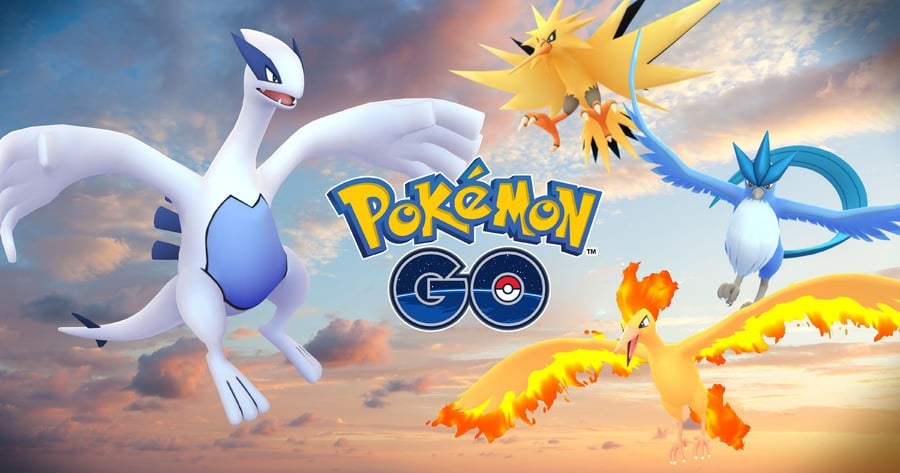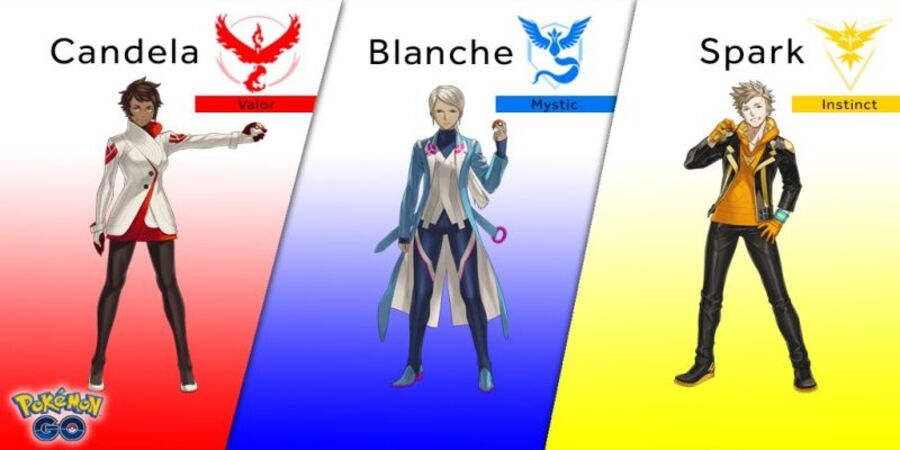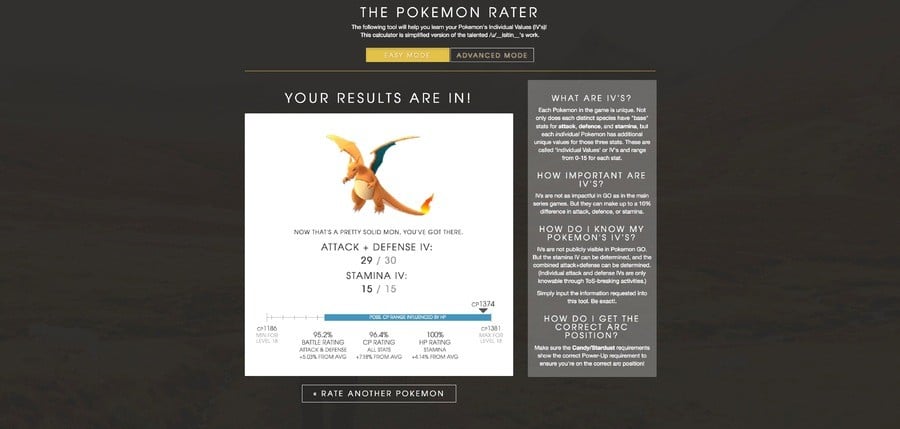
Each Pokémon in Pokémon GO has three IVs, or Individual Values, which determine that particular Pokémon's HP, defence, and attack scores. These are determined at random, and there's no way at present to change a Pokémon's IVs directly.
IVs in Pokémon GO are almost as mysterious as Legendary Pokémon. You know they're there because certain Pokémon perform better in battle than others, and raise the eyebrows of your Team Leader during an appraisal, but they're completely invisible to you.
That is, unless you use one of the readily available IV calculators. These come in a variety of different forms, but all of them have the same function: to give you an accurate reading of your Pokémon's IVs. Generally, the higher the CP of the Pokémon the more accurate the reading. Pair this with an appraisal by your team leader, and you can get a 100% accurate reading.
In this guide, we're going to explain exactly how IVs work in Pokémon GO and how you can check them using an IV calculator.
On this page: Pokémon GO IVs - How To Check A Pokémon's IVs Using An IV Calculator
Pokémon GO IVs Explained
IVs in Pokémon GO stand for Individual Values, and determine your Pokémon's ability in battle. There are three of them: Attack, Defence, and Stamina, and each has a score out of 15. Here's a breakdown of how they work:
| Attack | Defence | Stamina |
|---|---|---|
| Determines the damage of your attacks | Determines the damage received when attacked | Determines your HP |
IVs should not be confused with your Pokémon's base stats though. Each species of Pokémon has a set of base stats – Chansey has high Stamina, Flareon high Attack, and Golem high Defence for example – while each individual Pokémon has a set of IVs, which basically determine the potential increase of a stat when levelling up.
To put this simply, a Chansey will always have generally higher HP than most other Pokémon – even if it has a low Stamina IV. That's because its has a high base stamina. Its IV rating, instead, determines how much HP it gains when it powers up.

Now that you understand this system you can start making decisions about the Pokémon you want to use in different situations and the IVs you're comfortable with for said Pokémon. You'll probably want a Pokémon with high base Stamina and a high Stamina IV to sit in gyms, for example, as they'll last much longer. Conversely, you might want a Pokémon with a high base Attack and IVs when attacking gyms.
How To Check A Pokémon's IVs In Pokémon GO
The first stage of checking a Pokémon's IVs is to have them appraised by your Team Leader. To do so, tap on the Pokéball, tap on Pokémon, then on the Pokémon you want appraised. Now, tap the three lines on the bottom right of the screen and hit Appraise.
Your Team Leader will now give you a bunch of cryptic clues as to the Pokémon's IVs. The first set of clues relate to a Pokémon's IV Range, which is the score out of 100 for a Pokémon's potential. A score of 100 means that your Pokémon has a maximum score of 15 for each of its IVs.
This is what those clues mean:
| Valor | Mystic | Instinct | IV Range |
|---|---|---|---|
| Overall, your Pokémon simply amazes me! It can accomplish anything! | Overall, your Pokémon is a wonder! What a breathtaking Pokémon! | Overall, your Pokémon looks like it can really battle with the best of them! | 81 - 100% |
| Overall, your Pokémon is a strong Pokémon. You should be proud! | Overall, your Pokémon has certainly caught my attention. | Overall, your Pokémon is really strong! | 66 - 80% |
| Overall, your Pokémon is a decent Pokémon. | Overall, your Pokémon is above average. | Overally, your Pokémon is pretty decent! | 51 - 65% |
| Overall, your Pokémon may not be great in battle, but I still like it! | Overall, your Pokémon is not likely to make much headway in battle. | Overall, your Pokémon has room for improvement as far as battling goes. | 0 - 50% |
Your Team Leader will then tell you your Pokémon's highest IV. If a Pokémon has two stats with equally high IVs, the Team Leader will tell you both of them.

Directly following this, the Team Leader will then give you an estimate of how high that IV might be. Here's what they mean:
| Valor | Mystic | Instinct | Highest IV Range |
|---|---|---|---|
| I'm blown away by its stats. WOW! | Its stats exceed my calculations. It's incredible! | Its stats are the best I've ever seen! No doubt about it! | 15 |
| It's got excellent stats. How exciting! | I am certainly impressed by its stats, I must say. | It's stats are really strong! Impressive. | 13 - 14 |
| Its stats indicate that in battle, it'll get the job done. | Its stats are noticeably trending to the positive. | It's definitely got some good stats. Definitely! | 8 - 12 |
| It's stats don't point to greatness in battle. | Its stats are not out of the norm, in my opinion. | Its stats are all right, but kinda basic, as far as I can see. | 0 - 7 |
Unless you clearly have a max IV score of 15 for all three stats, this appraisal system merely gives you a rough estimate of your Pokémon's total IVs. It's a good place to start though, as you sort out the wheat from the chaff. Then you can go on to getting the exact IVs using an IV Calculator if you deem the Pokémon worthy.
How To Check A Pokémon's IVs Using An IV Calculator
An IV Calculator – of which there are many – can give you an accurate reading of your Pokémon's IVs, its level, and the power of its skills. It achieves this by looking at your Trainer Level, the Pokémon's CP (Combat Power), and the amount of Stardust required to power it up.
This provides a rough estimate, which increases in accuracy the higher the level of your Pokémon. You can also combine this with an Appraisal to get a more accurate reading.

IV Calculators, much like cars, come in two different flavours: automatic and manual. Automatics scan a screenshot of your Pokémon and calculate its IVs based on that, while manual requires you to input the information yourself.
The automatic method is not only the fastest but the most foolproof, as getting the IV range in the correct position can be particularly tough. If that's the method you want to go for, you'll need to download an app on your mobile. Here are our favourites:
If you'd rather not download an app on your mobile, these are our favourite manual options you can use in your browser:
Generally, these manual options are pretty straightforward to use. Choose your Pokémon, input its CP, HP, and the Stardust required to power it up – all of which is available while viewing a Pokémon in Pokémon GO. We'd also recommend including the Appraisal results, as these will really help provide a more accurate rating.
This article is part of our Pokémon GO walkthrough and guide series. We have articles that take you through the basics, covering How To Catch Pokémon: Throwing Tips, Poké Balls, & Capture Rates, How To Redeem Pokémon GO Promo Codes, How To Check A Pokémon's IVs Using An IV Calculator, How Trading Works, How To Track Pokémon Using Maps And Trackers, What Star Pieces And Stardust Do And How To Get Them, How Player Vs. Player Trainer Battles Work, and How To Complete Field Research And Research Breakthroughs And All Rewards.
We cover regular weekly and monthly Pokémon GO events, such as Spotlight Hour Times And Bonus Hour Times, and Community Days. We also have charts, including a Type Chart With Effectiveness And Weakness For All Types, an Egg Chart Explaining 2km, 5km, 7km, & 10km Eggs, and a Buddy Chart Explaining How To Earn Candy.
Elsewhere we cover Friend Code And Sharing Them For Easy XP and Which Pokémon GO 'Auto Catch' Companion Device Is The Best, plus more advanced tactics and info such as All Fast Moves And Charge Moves, How To Get TMs, And How It All Works, Shiny Pokémon And How To Catch Them, Glacial Lures, Magnetic Lures, Mossy Lures in Pokémon GO (And Their Exclusive Evolutions), How To Get Lots Of Candy Fast, How Lucky Pokémon Work & How To Catch Them, How To Catch All 27 Regional Pokémon, the Best Attackers And Best Defenders, All Raid Bosses And Best Counters Listed By Tier, What EX Raids Are And How To Get EX Raid Passes, What A Super Incubators Does And How To Get One, and How Get Mega Energy.
Pocket Monster-wise, we have specific guides for How To Get Pangoro, Sylveon, Glaceon, Aromatisse, Slurpuff, Sirfetch’d, Galarian Cofagrigus And More, How To Get Sylveon, Leafeon, Glaceon, Umbreon, Espeon, Vaporeon, Jolteon And Flareon, How To Evolve Wurmple Into Silcoon Or Cascoon, How To Get Tyrogue, Hitmonlee, Hitmonchan And Hitmontop, How To Use The Weather To Get Each Castform Form, How To Catch And Evolve Into Galarian Slowbro, How To Catch Smeargle, How To Find And Evolve Burmy, How To Catch Spinda, Where To Find Unown, How To Catch Ditto, and The Rarest Pokémon Including Wild, Shiny, Mythical And Regional Catches.
We also cover timed research and special events, including Mew's 'A Mythical Discovery', Jirachi's 'A Thousand-Year Slumber', Celebi's 'A Ripple In Time', and Regigigas' 'A Colossal Discovery'. Other (past) event guides include Twitch Codes List - Pokémon World Championship 2022, How To Battle A Challenger (World Championships 2022), How To Battle Fashion Challengers, 'A Spooky Message' Spiritomb Quest, Kanto Event FAQ, and the Summer Tour 2018 Chicago GO Fest And Dortmund And Yokosuka Safari Zones.
Finally, there's our WIP Pokémon GO Pokédex, which currently goes up to 400 Pokémon: #1-50 | #51-100 | #101-150 | #151-200 | #201-250 | #251-300 | #301-350 | #351-400.





Comments 11
Why did this guide just now come out? Thought this info had been available for a while.
How exciting! Yet another Glen Joke, guide (who doesn't seem to have a clue about RPGs), which probably rips off information from a website.
I wonder why they thought Pokemon GO needed IVs? I was kind of hoping they would get rid of them in the main games too. Hidden stats shouldn't be a thing, especially ones you have to spend hours to get "perfect".
@NiaBladerunner If you saw how hard Glen works on these as I do you wouldn't be so quick to judge.
If for whatever reason you don't believe our content to be up to your standards, we encourage you to seek another outlet that fulfils your requirements.
What's the risk of something like PokeGenie leading to a ban? Is it considered cheating by Niantic? Not a rhetorical question - I honestly don't know.
EDIT: It seems PokeGenie uses offline screenshots and does not access Niantic servers at all. This is really cool!
@AlexOlney crumbs Alex, do you need to hand out burn heal with your comments as well? 🤣
@riChchestM all these IV calculators just read your screen/screenshots. They don't interact with the game or its APIs at all, so there's no risk of a ban. I've been using CalcyIV myself for a long time with no detrimental effects.
@AlexOlney Not a problem, I will be happy to search for another Nintendo outlet that strives on facts and actual timely info, without the need to resort to misinformation and/or click/flamebait. Tally-ho!
@HipsterDashie - Articuno beats your Dragonite!
I haven't found it's remotely worth going out of your way for IVs in this game. This isn't the real Pokemon game, all that really matters is that the Pokemon in question has useful moves.
There is no real min/max to worry about, nor are there speed ties where your perfect IV will outspeed that other Pokemon that only has a 30/31.
@NotAceAttorney IV's are part of the experience. In the original games they were used to encourage the sacred trio: catch, trade and battle. It gave you the feeling that you had a special Pokémon because it is rare that two people get the very same exact IV's on normal gameplay. Once the competitive scene sprung into the mainstream territory it turned into a hassle for some, but I still value it for what it is. Besides, if you don't really want to go through all the trouble to get a perfect Pokémon, you can always play in Pokémon Showdown with a perfect team.
IVs have been found to be nothing more than bonus stats that amount to an immeasurable boost in gym battles. There are many articles on this, many videos on this, and much discussion about this.
At the current time, IVs just serve to be a VERY tiny bonus stat. But ... I still chase 100 IV Pokemon
DEFENSE
(Spellcheck! Geez ..)
Tap here to load 11 comments
Leave A Comment
Hold on there, you need to login to post a comment...